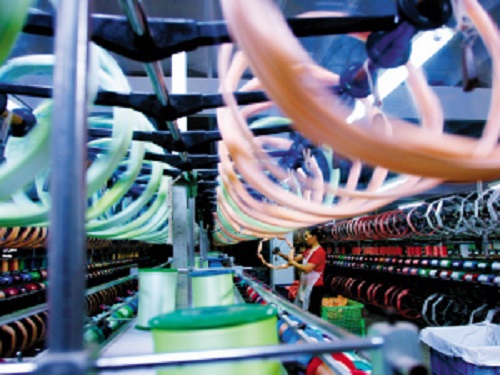
Textiles and clothing are the two most traditional labor-intensive export products in China and account for a large proportion of China's export products. However, since the beginning of this year, the export situation of China's textiles and clothing has been not optimistic. From January to September, the cumulative value of exports was US$211.33 billion, a decrease of US$10.42 billion from the same period of the previous year, of which the value of textile exports was US$81.86 billion, which was a year-on-year decrease of 1.5%; The value of goods was US$129.47 billion, a year-on-year decrease of 6.7%. This is the first time that cumulative negative growth has occurred in the past five years.
Labour-intensive industries represented by textiles and clothing are facing four major tests:
The cost advantage has diminished and corporate profits have shrunk. In the past, thanks to abundant and cheap labor advantages, China’s labor-intensive products have a large price advantage in the international market. However, since 2010, the growth rate of the total amount of migrant workers in China has continued to decline, and there has been a labor shortage. At the same time, wages of migrant workers continued to rise. From 2010 to 2014, wage growth rates of migrant workers were 19.3%, 21.2%, 11.8%, 13.9%, and 9.8%, respectively. According to the survey data, the labor cost in China is 2.5 to 5 times that of countries such as Vietnam and Bangladesh. Labor costs have been rising year by year, making the company's profit margins squeezed, and some companies' export gross margins have even dropped below 1%.
The overseas consumer market was weak and external demand declined. At present, the global economy is still in a period of deep adjustment after the financial crisis, and the economy is relatively weak. In particular, the EU and Japan, which account for nearly 30% of China's textile and clothing industry's export share, have suffered a sluggish economy and Chinese orders have thus significantly decreased. In the first half of 2015, China’s exports of textiles and clothing to the EU and Japan fell by 8.6% and 12.5% ​​year-on-year, respectively, lowering the industry’s export growth rate by 2.5%.
Emerging economies have emerged and international competition has intensified. As the price advantage of China’s labor-intensive industries has weakened, some overseas orders have shifted to emerging economies such as Vietnam, India, Indonesia, and Cambodia, where human costs are lower. From 2010 to 2014, the average growth rate of China's textile and apparel exports was 12.6%, while Vietnam's average growth rate reached 18.3% over the same period. Vietnam has become the second largest source of textiles in the United States. At the same time, Vietnam and other countries attach great importance to the issue of international trade policy. In May 2015, Vietnam and South Korea signed a free trade agreement. South Korea reduced tariffs on Vietnam's 95.43% tax-included goods, including textiles. In recent days, Vietnam completed negotiations with all TPP-related countries. After the agreement is signed, textiles and clothing are enjoyed. Zero tariffs, well below the current tax rate of 17% to 32%, are expected to increase the export market share by a factor of two.
The original industrial model is unsustainable and transformation and upgrading are imminent. China's labor-intensive industries have long followed the low-cost expansion and quantity-winning growth model for OEMs, with medium- and low-end products and processes as the mainstay, with low technological content and added value, and few independent brands. With the increase in labor costs and other factors, China's labor-intensive industries are losing their original competitiveness in some low-end markets, pushing them to upgrade their technological content, productivity, and higher quality. Enterprises will face enormous challenges. With regard to capital investment and operational risks, the survival of the fittest will increase.
In view of the above, Shandong Weihai Inspection and Quarantine Bureau recommends that exporting companies should innovate products, technologies, and services, build brands, innovate technologies to enhance competitiveness, change low-price competition business strategies, and rely on market-driven development to promote the industry. High-end, intelligent transformation and upgrading; full use of national strategic opportunities such as “One Belt and One Roadâ€, qualified companies can carry out efficient and rational allocation of transnational resources, actively and steadily “going out†to enhance the position of the global industrial value chain. At the same time, relevant departments should also give enterprises better policies and financial support, guide enterprises to analyze the international market conditions, seize international market opportunities, and help enterprises improve export efficiency.
SD"brand is renowned for a full seriers of faux fur belonging to Wuxi Shuangda Plush Co., Ltd. Faux fur products, looking similar to natural animal fur, combine the luxury and fashion .
The upscale faux fox fur and knitting wool products reach the domestic and international high level. Products have been exported to the United States, Australia, Japan, Russia and Vietnam. In addition, according to the report from international accredited testing institutions, the test of formaldehyde in some products is ND level. The company receives high praise from the international specialists.
Tops Knitting Fur,Long Hair Fake Fur,Long Hair Faux Fur,Fashion Tip Fake Fur
Wuxi Shuanglida Plush Technology Co., LTD , https://www.sd-fauxfur.com
